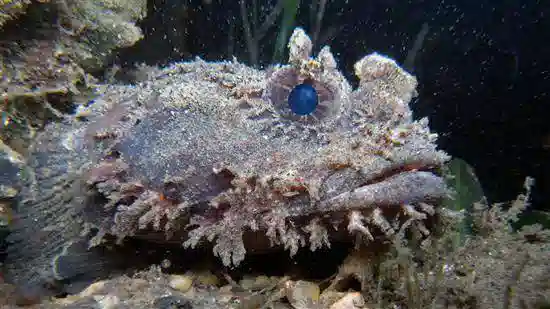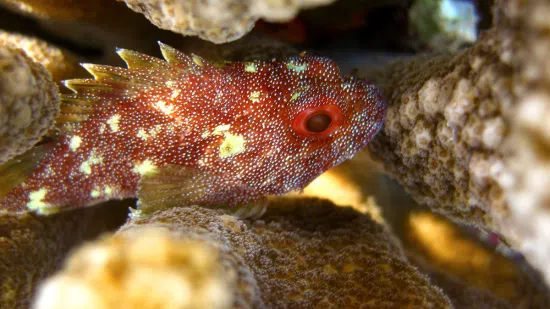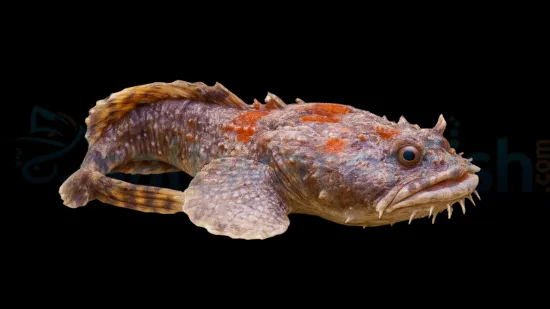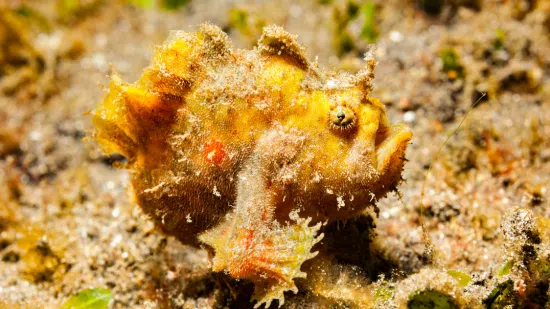Toadfish: Orange - Atlantic
Opsanus beta
(1 Reviews)

Toadfish: Orange - Atlantic
Opsanus beta
(1 Reviews)
{{ item.name }}
Size: {{ item.extra_field_3 }}
${{ getFormattedPrice(item.saleprice) }} ${{ getFormattedPrice(item.price) }}
To join the waiting list, click here
Free Shipping
With
$199.00
or more in Marine Life.
More details...
Toadfish: Orange - Atlantic Care Facts
| Care Level: | Easy |
|---|---|
| Temperament: | Aggressive |
| Diet: | Carnivore |
| Reef Safe: | No |
| Minimum Tank Size: | 100 Gallons |
| Max Size: | 12 inches |
The Toadfish, Opsanus beta, hails from the waters of the Gulf of Mexico and is almost always a orange/brown hue. It is a bottom dwelling predator that seeks out small fish and inverts. It is best kept in a large aquarium void of these small organisms. With such a large mouth and a large appetite, the Toadfish can make many small organisms prey. They are hardy and can handle large fluctuations in tank specs.
The Orange Toadfish Care Guide: From SaltWaterFish.com
The Orange Toadfish, scientifically known as Opsanus beta, is a unique and intriguing species that can make an exciting addition to your saltwater marine aquarium. In this comprehensive product description, we will delve into various aspects of this captivating fish, including its habitat, reef compatibility, size, lifespan, diet in captivity, aquaculture availability, compatibility with other aquatic life, sexual dimorphism, coloration changes from juvenile to adult, temperament, tank requirements, water conditions, common names, compatible tank mates, and the reasons why Saltwaterfish.com is your ideal source for acquiring this species.
Habitat and Natural Range of the Orange Toadfish
Opsanus beta, commonly called the Orange Toadfish, is predominantly found along the Atlantic coast of North America, from Nova Scotia to the Gulf of Mexico. This species inhabits shallow coastal waters, estuaries, and intertidal zones, often seeking refuge in seagrass beds and sandy substrate. Their preference for such environments significantly influences their care in captivity.
Reef Compatibility of the Orange Toadfish
The Orange Toadfish is not considered reef-safe due to its natural inclination to bury itself in sand and substrate. This behavior may disrupt and potentially harm delicate corals and other reef organisms. They will also prey on small fish and inverts. Therefore, keeping this species in a fish-only or species-specific aquarium is advisable.
Size and Lifespan of the Orange Toadfish: Impressive Dimensions
Orange Toadfish can grow up to 12 inches (30 centimeters) in length when fully mature. They have a relatively long lifespan for marine fish, with individuals in captivity often living up to 10 to 15 years when provided with proper care and conditions.
Diet in Captivity: Requirements for the Orange Toadfish
These carnivorous fish have a hearty appetite and will readily accept a variety of meaty foods in captivity. Their diet should consist of high-quality marine pellets, frozen or live foods such as shrimp, small fish, and squid. A varied diet will ensure the health and vitality of your Orange Toadfish.
Aquaculture Availability of the Orange Toadfish: Unique and Sought-After
Orange Toadfish are not commonly available through aquaculture and are primarily collected from the wild. It is essential to check with reputable suppliers like Saltwaterfish.com for the most current availability status.
Compatibility of the Orange Toadfish with Other Fish and Invertebrates
Orange Toadfish are known for their solitary nature and can be territorial, mainly when established in their burrows. Therefore, it is advisable to house them in a dedicated tank without other aggressive or territorial species. Peaceful tank mates of similar size may be tolerated.
Sexual Dimorphism of the Orange Toadfish: Subtle Differences
Sexual dimorphism in Orange Toadfish is not prominently displayed, making it challenging to differentiate between males and females based on external characteristics alone. To determine the sex of these fish accurately, examination of their reproductive organs is necessary.
Juvenile to Adult Coloration Changes in the Orange Toadfish
Orange Toadfish exhibit a fascinating coloration change as they mature. Juveniles often have a mottled or speckled appearance in shades of brown and gray, which serves as camouflage in their natural habitat. As they reach adulthood, their coloration transforms into a stunning orange hue with distinct patterns, making them genuinely captivating additions to your aquarium.
Temperament of the Orange Toadfish
These fish are generally calm and not aggressive towards other large fish species. However, they can be territorial regarding their burrows, so providing adequate hiding spots and territories within the tank is essential to prevent conflicts.
Tank Requirements for the Orange Toadfish: Creating the Perfect Habitat
- Minimum Aquarium Size: A tank with at least 100 gallons capacity is recommended for a single Orange Toadfish. Larger tanks are preferable for multiple individuals or if you plan to keep them with other fish.
- Substrate: A fine sand or crushed coral substrate is essential for the Orange Toadfish to exhibit their natural burrowing behavior.
- Hiding Spots: Provide PVC pipes or caves as hiding spots to mimic their preferred burrowing environment.
- Filtration: High-quality filtration and regular water changes are crucial to maintain excellent water quality.
- Water Conditions:
- pH: Maintain a stable pH level of 7.8 to 8.4.
- Salinity: Keep the salinity level between 1.020 and 1.025 specific gravity.
- Water Temperature: Maintain a water temperature between 72°F and 78°F (22°C - 26°C).
- Water Flow: Provide gentle to moderate water flow to simulate their natural habitat without creating strong currents.
Common Names for the Orange Toadfish
The Orange Toadfish may also be known by various names, including Gulf Toadfish, Oyster Toadfish, and Toadfish.
Five Compatible Tank Mates for the Orange Toadfish: Choosing the Right Companions
When considering tank mates for the Orange Toadfish, it's essential to choose species that are peaceful, of similar size, and can tolerate their territorial behavior. Here are five compatible tank mates:
- Tangs (Acanthurus spp.)
- Angelfish (Pomacanthidae family)
- Butterfly Fish (Chaetodon family)
- Tomato Clownfish (Amphiprion frenatus)
- Puffer Fish (Tetraodontidae family)
Why Choose Saltwaterfish.com for Your Orange Toadfish: Trustworthy and Reliable
Saltwaterfish.com is your trusted source for acquiring Orange Toadfish and other marine species for several compelling reasons:
- Quality Assurance: They ensure the health and quality of their fish through rigorous selection and quarantine processes.
- Knowledgeable Staff: The team at Saltwaterfish.com is well-versed in marine aquarium care and can provide expert guidance.
- Wide Selection: You can find a variety of marine species and products, allowing you to build and maintain a thriving saltwater aquarium.
- Customer Support: They offer excellent customer support to address any questions or concerns you may have throughout your aquarium journey.
In conclusion, the Orange Toadfish (Opsanus beta) is a captivating addition to your saltwater marine aquarium. You can enjoy their intriguing behavior for many years with proper care and consideration of their unique characteristics. When looking to acquire this species, trust Saltwaterfish.com for a reliable source that prioritizes the health and well-being of your aquatic companions.
Great quality and arrived healthy.
Reviewed by: Tyty on May 15, 2020















